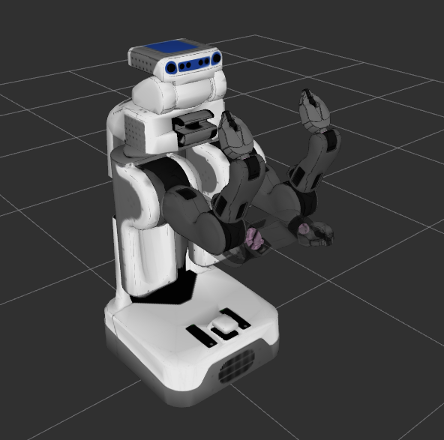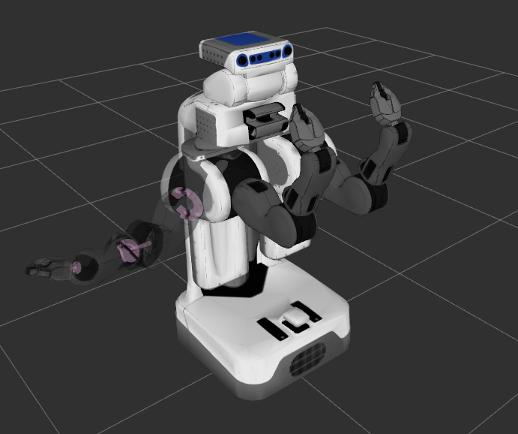Motion Planners Tutorial¶
In MoveIt!, the motion planners are loaded using a plugin infrastructure. This allows MoveIt! to load motion planners at runtime. In this example, we will run through the C++ code required to do this.
Start¶
Setting up to start using a planner is pretty easy. Planners are setup as plugins in MoveIt! and you can use the ROS pluginlib interface to load any planner that you want to use. Before we can load the planner, we need two objects, a RobotModel and a PlanningScene. We will start by instantiating a RobotModelLoader object, which will look up the robot description on the ROS parameter server and construct a RobotModel for us to use.
robot_model_loader::RobotModelLoader robot_model_loader("robot_description");
robot_model::RobotModelPtr robot_model = robot_model_loader.getModel();
Using the RobotModel, we can construct a PlanningScene that maintains the state of the world (including the robot).
planning_scene::PlanningScenePtr planning_scene(new planning_scene::PlanningScene(robot_model));
We will now construct a loader to load a planner, by name. Note that we are using the ROS pluginlib library here.
boost::scoped_ptr<pluginlib::ClassLoader<planning_interface::PlannerManager> > planner_plugin_loader;
planning_interface::PlannerManagerPtr planner_instance;
std::string planner_plugin_name;
We will get the name of planning plugin we want to load from the ROS param server, and then load the planner making sure to catch all exceptions.
if (!node_handle.getParam("planning_plugin", planner_plugin_name))
ROS_FATAL_STREAM("Could not find planner plugin name");
try
{
planner_plugin_loader.reset(new pluginlib::ClassLoader<planning_interface::PlannerManager>("moveit_core", "planning_interface::PlannerManager"));
}
catch(pluginlib::PluginlibException& ex)
{
ROS_FATAL_STREAM("Exception while creating planning plugin loader " << ex.what());
}
try
{
planner_instance.reset(planner_plugin_loader->createUnmanagedInstance(planner_plugin_name));
if (!planner_instance->initialize(robot_model, node_handle.getNamespace()))
ROS_FATAL_STREAM("Could not initialize planner instance");
ROS_INFO_STREAM("Using planning interface '" << planner_instance->getDescription() << "'");
}
catch(pluginlib::PluginlibException& ex)
{
const std::vector<std::string> &classes = planner_plugin_loader->getDeclaredClasses();
std::stringstream ss;
for (std::size_t i = 0 ; i < classes.size() ; ++i)
ss << classes[i] << " ";
ROS_ERROR_STREAM("Exception while loading planner '" << planner_plugin_name << "': " << ex.what() << std::endl
<< "Available plugins: " << ss.str());
}
/* Sleep a little to allow time to startup rviz, etc. */
ros::WallDuration sleep_time(15.0);
sleep_time.sleep();
Pose Goal¶
We will now create a motion plan request for the right arm of the PR2 specifying the desired pose of the end-effector as input.
planning_interface::MotionPlanRequest req;
planning_interface::MotionPlanResponse res;
geometry_msgs::PoseStamped pose;
pose.header.frame_id = "torso_lift_link";
pose.pose.position.x = 0.75;
pose.pose.position.y = 0.0;
pose.pose.position.z = 0.0;
pose.pose.orientation.w = 1.0;
A tolerance of 0.01 m is specified in position and 0.01 radians in orientation
std::vector<double> tolerance_pose(3, 0.01);
std::vector<double> tolerance_angle(3, 0.01);
We will create the request as a constraint using a helper function available from the kinematic_constraints package.
req.group_name = "right_arm";
moveit_msgs::Constraints pose_goal = kinematic_constraints::constructGoalConstraints("r_wrist_roll_link", pose, tolerance_pose, tolerance_angle);
req.goal_constraints.push_back(pose_goal);
We now construct a planning context that encapsulate the scene, the request and the response. We call the planner using this planning context
planning_interface::PlanningContextPtr context = planner_instance->getPlanningContext(planning_scene, req, res.error_code_);
context->solve(res);
if(res.error_code_.val != res.error_code_.SUCCESS)
{
ROS_ERROR("Could not compute plan successfully");
return 0;
}
Visualize the result¶
ros::Publisher display_publisher = node_handle.advertise<moveit_msgs::DisplayTrajectory>("/move_group/display_planned_path", 1, true);
moveit_msgs::DisplayTrajectory display_trajectory;
/* Visualize the trajectory */
ROS_INFO("Visualizing the trajectory");
moveit_msgs::MotionPlanResponse response;
res.getMessage(response);
display_trajectory.trajectory_start = response.trajectory_start;
display_trajectory.trajectory.push_back(response.trajectory);
display_publisher.publish(display_trajectory);
sleep_time.sleep();
Joint Space Goals¶
/* First, set the state in the planning scene to the final state of the last plan */
robot_state::RobotState& robot_state = planning_scene->getCurrentStateNonConst();
planning_scene->setCurrentState(response.trajectory_start);
const robot_state::JointModelGroup* joint_model_group = robot_state.getJointModelGroup("right_arm");
robot_state.setJointGroupPositions(joint_model_group, response.trajectory.joint_trajectory.points.back().positions);
Now, setup a joint space goal
robot_state::RobotState goal_state(robot_model);
std::vector<double> joint_values(7, 0.0);
joint_values[0] = -2.0;
joint_values[3] = -0.2;
joint_values[5] = -0.15;
goal_state.setJointGroupPositions(joint_model_group, joint_values);
moveit_msgs::Constraints joint_goal = kinematic_constraints::constructGoalConstraints(goal_state, joint_model_group);
req.goal_constraints.clear();
req.goal_constraints.push_back(joint_goal);
Call the planner and visualize the trajectory
/* Re-construct the planning context */
context = planner_instance->getPlanningContext(planning_scene, req, res.error_code_);
/* Call the Planner */
context->solve(res);
/* Check that the planning was successful */
if(res.error_code_.val != res.error_code_.SUCCESS)
{
ROS_ERROR("Could not compute plan successfully");
return 0;
}
/* Visualize the trajectory */
ROS_INFO("Visualizing the trajectory");
res.getMessage(response);
display_trajectory.trajectory_start = response.trajectory_start;
display_trajectory.trajectory.push_back(response.trajectory);
/* Now you should see two planned trajectories in series*/
display_publisher.publish(display_trajectory);
/* We will add more goals. But first, set the state in the planning
scene to the final state of the last plan */
robot_state.setJointGroupPositions(joint_model_group, response.trajectory.joint_trajectory.points.back().positions);
/* Now, we go back to the first goal*/
req.goal_constraints.clear();
req.goal_constraints.push_back(pose_goal);
context = planner_instance->getPlanningContext(planning_scene, req, res.error_code_);
context->solve(res);
res.getMessage(response);
display_trajectory.trajectory.push_back(response.trajectory);
display_publisher.publish(display_trajectory);
Adding Path Constraints¶
Let’s add a new pose goal again. This time we will also add a path constraint to the motion.
/* Let's create a new pose goal */
pose.pose.position.x = 0.65;
pose.pose.position.y = -0.2;
pose.pose.position.z = -0.1;
moveit_msgs::Constraints pose_goal_2 = kinematic_constraints::constructGoalConstraints("r_wrist_roll_link", pose, tolerance_pose, tolerance_angle);
/* First, set the state in the planning scene to the final state of the last plan */
robot_state.setJointGroupPositions(joint_model_group, response.trajectory.joint_trajectory.points.back().positions);
/* Now, let's try to move to this new pose goal*/
req.goal_constraints.clear();
req.goal_constraints.push_back(pose_goal_2);
/* But, let's impose a path constraint on the motion.
Here, we are asking for the end-effector to stay level*/
geometry_msgs::QuaternionStamped quaternion;
quaternion.header.frame_id = "torso_lift_link";
quaternion.quaternion.w = 1.0;
req.path_constraints = kinematic_constraints::constructGoalConstraints("r_wrist_roll_link", quaternion);
Imposing path constraints requires the planner to reason in the space of possible positions of the end-effector (the workspace of the robot) because of this, we need to specify a bound for the allowed planning volume as well; Note: a default bound is automatically filled by the WorkspaceBounds request adapter (part of the OMPL pipeline, but that is not being used in this example). We use a bound that definitely includes the reachable space for the arm. This is fine because sampling is not done in this volume when planning for the arm; the bounds are only used to determine if the sampled configurations are valid.
req.workspace_parameters.min_corner.x = req.workspace_parameters.min_corner.y = req.workspace_parameters.min_corner.z = -2.0;
req.workspace_parameters.max_corner.x = req.workspace_parameters.max_corner.y = req.workspace_parameters.max_corner.z = 2.0;
Call the planner and visualize all the plans created so far.
context = planner_instance->getPlanningContext(planning_scene, req, res.error_code_);
context->solve(res);
res.getMessage(response);
display_trajectory.trajectory.push_back(response.trajectory);
Now you should see four planned trajectories in series
display_publisher.publish(display_trajectory);
The entire code¶
The entire code can be seen here in the moveit_pr2 github project.
Compiling the code¶
Follow the instructions for compiling code from source.
The launch file¶
The entire launch file is here on github. All the code in this tutorial can be compiled and run from the moveit_tutorials package that you have as part of your MoveIt! setup.
Running the code¶
Roslaunch the launch file to run the code directly from moveit_tutorials:
roslaunch moveit_tutorials motion_planning_api_tutorial.launch
Expected Output¶
In Rviz, we should be able to see four trajectories being replayed eventually:
- The robot moves its right arm to the pose goal in front of it,
- The robot moves its right arm to the joint goal to the side,
- The robot moves its right arm back to the original pose goal in front of it,
- The robot moves its right arm back to a new pose goal while maintaining the end-effector level.
Open Source Feedback
See something that needs improvement? Please open a pull request on this GitHub page


